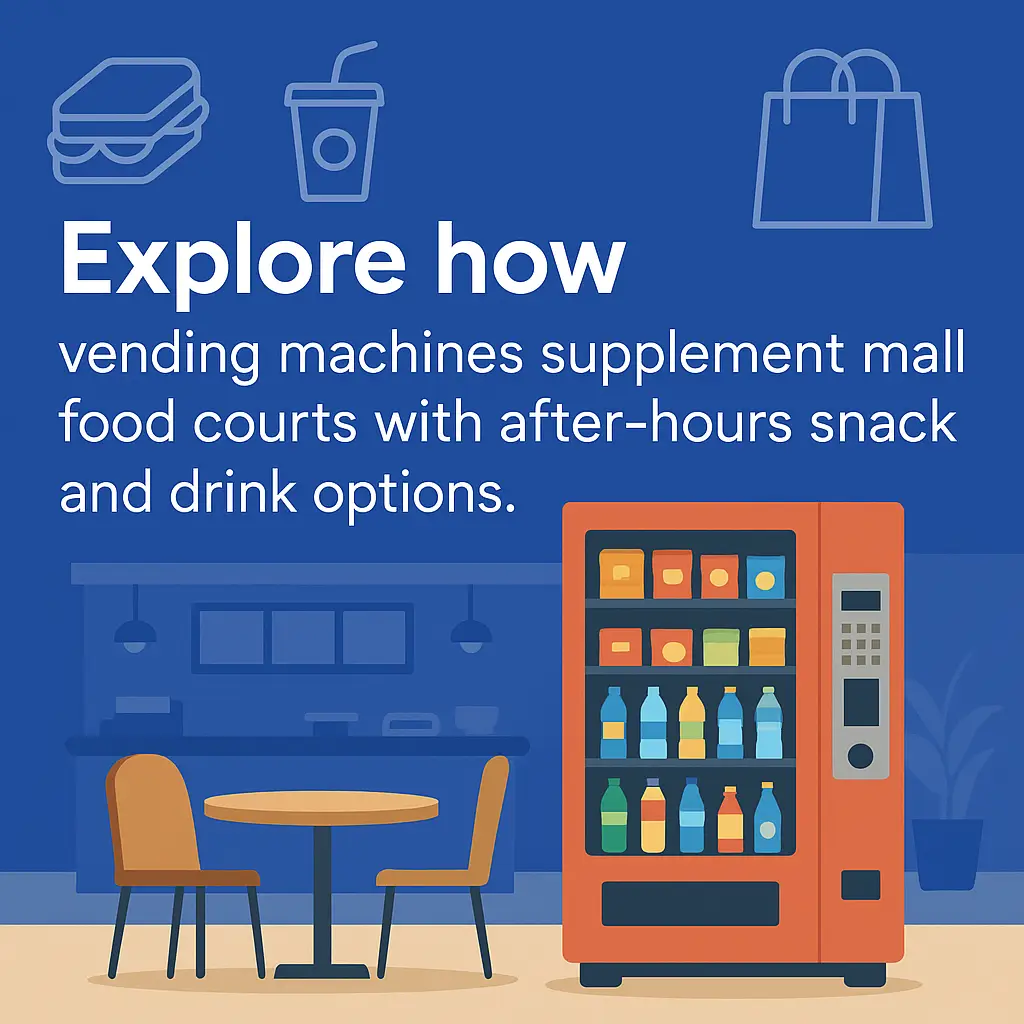Vending Machines in Mall Food Courts
Explore how vending machines supplement mall food courts with after-hours snack and drink options.
Back to Vending for Retail Locations ResourcesExplore how vending machines supplement mall food courts with after-hours snack and drink options.
Back to Vending for Retail Locations ResourcesVending machines extend convenience and choice by providing quick snacks and beverages during peak hours and after traditional food vendors close, supporting shopper needs around the clock.
![]() Capture impulse purchases near seating and entrances
Capture impulse purchases near seating and entrances
![]() Offer after-hours and event-driven refreshment options
Offer after-hours and event-driven refreshment options
![]() Support diverse preferences with healthy, indulgent, and seasonal selections
Support diverse preferences with healthy, indulgent, and seasonal selections

Malls are high-traffic environments where guests expect quick access to food and beverages. Vending machines complement food courts by filling service gaps—offering late-night snacks, unattended options during off-peak hours, and convenient impulse items near seating areas. Incorporating vending into a retail environment can improve guest satisfaction while creating incremental revenue streams for mall operators.
Food court vendors often close earlier than the mall or adjacent entertainment venues. Vending machines provide a reliable solution for guests seeking snacks or drinks after kiosk and vendor hours, particularly during movie showtimes or special events. Learn about equipment and full-service options in what is full-service vending.
Successful food court vending relies on selecting the right products for foot traffic patterns—cold beverages, snack mixes, healthy alternatives, and seasonal items. Modern machines with telemetry allow operators to track sales and tailor offerings quickly, ensuring high-turnover items stay available and less-popular products are rotated out.
Accepting contactless payments and mobile wallets increases conversion in retail settings where customers expect fast, card-based transactions. Machines equipped with cashless readers, remote monitoring, and dynamic pricing options create a frictionless experience for shoppers and reduce service calls. For examples of technology adoption in public spaces, see vending in entertainment venues.
Optimal machine placement—near high-visibility corridors, seating, and entrances—maximizes sales without causing congestion. Machines are designed for secure, durable service in open areas, and regular maintenance schedules plus surveillance reduce vandalism and downtime. For guidance on reliable service models, review approaches described in public building vending programs.
Mall visitors increasingly seek healthier options. Including clear labeling, low-sugar snacks, and fresh items alongside traditional treats broadens appeal and supports wellness-focused initiatives in retail centers. See strategies for healthy inventory in healthy vending in public facilities.
Installing vending machines usually requires minimal infrastructure—power and optional connectivity—and can be coordinated to respect mall design and tenant agreements. Operators typically handle stocking, servicing, and equipment upkeep, allowing mall management to offer added convenience with little operational overhead.
Interested in adding vending to your mall food court? Fill out the form on this page to explore placement, product selection, and payment technology tailored to your shopping center’s needs.
Vending machines offer convenient, on-demand snacks and beverages to shoppers, complementing food vendors and capturing impulse purchases throughout the day and evening.
Yes. Machines can operate independently and provide refreshments for late-night shoppers, moviegoers, and staff when other vendors are closed.
High-turnover items like bottled drinks, packaged snacks, grab-and-go sandwiches, coffee, and healthy snacks are popular with mall visitors.
Place machines near seating areas, entrances, corridors with heavy foot traffic, or next to entertainment venues to maximize visibility and convenience.
Most modern machines accept credit/debit, contactless, and mobile wallet payments, improving conversion and customer satisfaction.
Most units need standard electrical outlets and may use Wi‑Fi or cellular telemetry for inventory and payment processing; site evaluation determines exact needs.
Vending units are built with secure locks and reinforced cabinets; operators often coordinate with mall security and perform regular checks to deter vandalism.
Typically, the vending operator handles stocking, cleaning, and machine servicing so mall staff incur minimal operational burden.
Yes. Operators can rotate inventory for holidays, promotions, or mall events to match shopper preferences and boost sales.
Malls should review placement for traffic flow, accessibility compliance, power access, and revenue or lease terms to ensure a mutually beneficial arrangement.